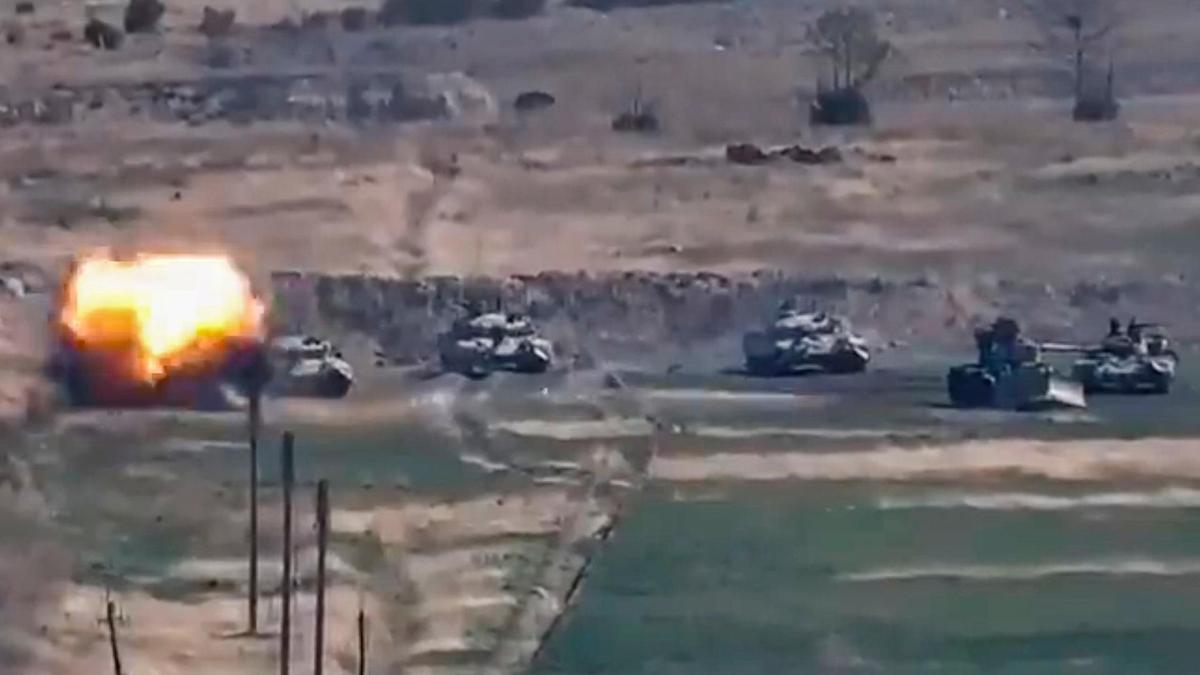
SOURCE: The Tribune
The fighting between Armenia and Azerbaijan has occupied little attention in the Indian media, but it is proving to be of great interest to the military community. As the war erupted over the disputed Nagorno-Karabakh enclave, both sides put out video footage showing tanks being destroyed by drones and precision artillery strikes.
The Azerbaijan military has deployed an array of drones, both for surveillance and attack. The latter, also known as ‘kamikaze’ drones, loiter over the battlefield, acquire targets like tanks and crash into them. On display were both Israeli and Turkish drones that have been obtained in large numbers by Baku over the past few years.
Both sides have claimed that hundreds of tanks, along with air defence launchers, artillery guns and other military equipment have been destroyed in the fighting. While it is difficult to assess the losses accurately, there is no doubt that drones have played a large role. The Armenian defence ministry statement that it has shot down 107 enemy drones indicates the extensive use of drones in the fighting.
The drone-vs-tank battle being witnessed in Nagorno-Karabakh is not a first. In February, 33 Turkish soldiers were killed in a Syrian airstrike on Idlib in northern Syria. In retaliation, Turkey unleashed a fierce offensive, primarily using drone-launched missiles and precision artillery strikes. In three days of fighting, Turkey claimed to have knocked out more than 100 armoured vehicles and killed over 2,000 soldiers.
At the forefront of the Turkish offensive were the Bayraktar-TB and Anka-S drone systems. These drones carry MAM-C and MAM-L high explosive, armour-penetrating rockets designed to strike targets illuminated by a laser. Surveillance drones were used to locate targets that were accurately engaged by long-range artillery and rocket systems. Supporting this ‘war from afar’ was the KORAL electronic warfare system that paralysed Syria’s air defence radar network and its ability to shoot down the drones.
Both these conflicts provide a glimpse of the future of warfare and have raised many questions on the viability of tanks on the battlefield. The US Marine Corps report Force Design 2030 states that the Corps will divest all of its tanks. It could be argued that the Marine Corps has a specific expeditionary role that requires it to remain a light force and that it is premature to write off the tank altogether from the battlefield. This argument has merit, but it is equally valid that the era of large tank-vs-tank battles appears to have passed.
In eastern Ladakh, India and China have deployed a considerable number of tanks in the ongoing standoff at the Line of Actual Control (LAC). The heavy T-72 and T-90 tanks of India are facing the Type 15 light Chinese tanks. Both sides claim superiority. The Chinese contend that their light tank is more suited for high-altitude operations while an Indian tank commander told ANI that in “a battle involving the tanks… I can assure you that it (Type 15 tank) won’t survive against our T-90s and the T-72s.” Both these points of view miss the larger picture: the main threat to a tank today is not from another tank, but from the air. And this is particularly true in the open, barren and vegetation-free terrain that characterises areas along the LAC.
The Chinese military has a large number of sophisticated unmanned aerial vehicles (UAV) and unmanned combat aerial vehicles (UCAV). There is a mix of medium- and high-altitude long-endurance UAVs and several UCAV models, including the GJ-11 stealth drone that was unveiled at the 2019 National Day parade. It is estimated that the People’s Liberation Army (PLA) has more than 20 variants of military drones in service.
The PLA has also invested heavily in electronic warfare. The Network Systems Department of the Strategic Support Force, raised in 2016, combines cyber and electronic warfare under one organisational umbrella. In a conflict, cyber and electronic attacks would be employed to degrade command and control and fire support networks, including air defence radars.
In these battle conditions, weapon platforms like tanks must adapt to become more survivable. This will require a change in tactics and greater integration of different types of capabilities. With a plethora of sensors on the battlefield, it has become almost impossible to hide. Tanks will have to operate widely dispersed, accompanied by electronic warfare units to detect and jam aerial platforms, and short-range air defence units capable of bringing down UAVs/UCAVs.
We also cannot fight these battles in a defensive mode and must acquire a formidable unmanned aerial attack capability. In a recent interview, the Indian Air Force chief pointed out the limitations of attack drones and the issue with the costs of acquiring this capability. He was referring to the ongoing discussions with the US to procure 20 armed MQ-9 UAVs for an estimated cost of $3 billion.
Every piece of military equipment has some limitations, and it is in the integration of systems that the whole becomes greater than the sum of its parts. As far as the cost is concerned, we must choose wisely. The Kratos XQ-58A Valkyrie stealth drone is currently under development in collaboration with the US Air Force. With a range of almost 4,000 km and a weapon payload of 250 kg, the Valkyrie comes with a $2 million apiece price tag. That translates to 50 drones for the cost of one Rafale aircraft.
The conflict in Nagorno-Karabakh may be limited in scope but provides vital indicators for future war-fighting. The Spanish Civil War (1936-39) provided many invaluable lessons for the German military, especially in the employment of airpower, which were later applied in the Second World War. The Indian military is currently heavily invested in traditional platforms like tanks, aircraft and battleships. I am not suggesting that we sound the death knell for these platforms, but we must also be open to adopting new technologies with greater enthusiasm than has been shown.






